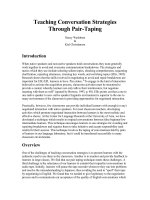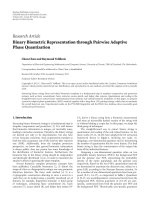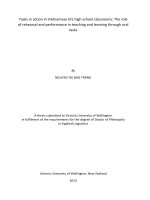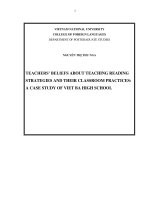Teaching Conversation Strategies Through Pair
Bạn đang xem bản rút gọn của tài liệu. Xem và tải ngay bản đầy đủ của tài liệu tại đây (121.99 KB, 10 trang )
Teaching Conversation Strategies
Through Pair-Taping
Nancy Washburn
&
Kiel Christianson
Introduction
When native speakers and non-native speakers hold conversations they must generally
work together to avoid and overcome communication breakdowns. The strategies and
tactics which they use include selecting salient topics, checking comprehension, requesting
clarification, repeating utterances, stressing key words, and switching topics (Ellis, 1985).
Research shows that the skills involved in negotiating to avoid and repair breakdowns are
important for ESL/EFL learners to have. Pica states, "To engage in the kind of interaction
believed to activate the acquisition process, classroom activities must be structured to
provide a context whereby learners not only talk to their interlocutors, but negotiate
meaning with them as well" (quoted by Browne, 1993, p. 40). Ellis points out that a one to
one native speaker to non- native speaker linguistic environment is superior to the one to
many environment of the classroom in providing opportunities for negotiated interaction.
Practically, however, few classrooms can provide individual learners with enough (or any)
negotiated interaction with native speakers. For most classroom teachers, developing
activities which promote negotiated interaction between learners is the most realistic and
effective choice. At the Center for Language Research at the University of Aizu, we have
developed a technique which results in original conversations between false beginner/low
intermediate learners. This technique encourages learners to use strategies for avoiding and
repairing breakdowns and requires them to take initiative and accept responsibility (and
credit) for their success. This technique involves the taping of conversations held by pairs
of learners in our language laboratory, but it could be transferred successfully to many
classroom environments.
Overview
One of the challenges of teaching conversation strategies is to present learners with the
authentic need to use them in the classroom. Another is to monitor and provide feedback to
learners in large classes. We find that our pair taping technique meets these challenges. A
third challenge is the reluctance of our learners to commit their imperfect conversations to
audio tape. Initially, learners will pause the tape recorder whenever they run into problems
and resolve the misunderstanding in Japanese, thus avoiding the need to "spoil" their tape
by negotiating in English. We found that we needed to give legitimacy to the negotiation
process and to communicate our acceptance of the quality of English conversations which
learners at their level are able to hold. We do this by presenting the conversation strategies
via audio and video tapes of natural conversations held by sophomores and more advanced
freshman. The videotaped conversations are planned in advance by the participants for the
inclusion of certain strategies, but they are unscripted. The audio tapes are taken from those
made in class by former and current students. These tapes are very efficient in
communicating the task and in reassuring our learners that they can succeed in meeting
expectations. Then the class, working in pairs or groups of three, hold original
conversations and tape them. Learners make a lot of mistakes while having these
conversations, creating an authentic need to use the strategies they have just studied.
Teachers monitor the appropriate use of strategies by listening to the tapes and writing tape
evaluations.
There is growing evidence that such conversations between learners can be productive.
Clennell (1994), in his observations of classrooms, noticed "an extraordinary change in the
learners' behavior...when the teacher moved away" from groups of students having a
conversation. He saw a marked increase in fluency, improvisation, and creative use of
words (p. 32). Schneider (1993, 1994) has found a higher level of achievement in terms of
fluency and listening comprehension test scores among his students who have chosen to do
pair- taping over attending traditional class sessions. Ernst (1994) has also found student-
generated conversation in "Talking Circles" effective in teaching conversation strategies,
grammar, and English sociolinguistic norms. Skeptics of such a straightforward approach
raise legitimate concerns. Students might give each other "faulty" input. Students might
have the same conversation over and over again. Students might rely solely on
communication strategies which they already know or which are inappropriate. Students
might avoid ESP content in their conversations. With these concerns in mind, we have built
in some safeguards against the pitfalls of student-generated communication. Moreover, our
use of the students' own production to introduce conversation strategies gives them a much-
needed boost of self-confidence and lends legitimacy to the process of negotiating meaning
with which learners must become comfortable.
The first objection above, that of students teaching students incorrectly, is based on the
assumption that learning is simply the transfer of information from someone who is more
knowledgeable to someone who is less knowledgeable; however, Glachan and Light state
"interaction between inferior strategies can lead to superior strategies, or in other words,
two wrongs can make a right" (1982, p. 258, as quoted in van Lier, 1994, p. 8). In many
thousands of minutes of "What's New?" tapes, we have found just one instance of a student
correcting another student incorrectly, and he was not believed. We feel that the benefits
for acquisition of two inferior strategies negotiating to find a superior one outweigh the
possible drawbacks from learners conversing freely with each other.
That learners might have the same conversation over and over again is a problem that is
discouraged by the very name of the activity: "What's new?" This question begins every
conversation and implicitly demands a "new" topic. Most important for originality, we
have found that our first term freshmen become very invested in holding these
conversations and use them as opportunities to get to know each other. Even learners who
are reluctant to talk on any given day seem to treat "What's New?" as a meaningful
question and in the course of the conversation warm up to giving a genuine response. That
learners may use strategies incorrectly or inappropriately is a concern which we meet by
monitoring tapes and giving written feedback (examples below).
THE "WHAT'S NEW?" PROGRAM
General considerations
Over the course of the semester, teachers introduce various conversation strategies to assist
learners in holding their weekly conversations. They are required to tape these
conversations and to complete them within a time frame (3 to 15 minutes, at the discretion
of the teacher). They are forbidden to stop the tape player before the time is up, so learners
quickly discover their urgent need for the basic strategies, and motivation to use them is
high. Learners are evaluated on the appropriate use of a strategy from the time it has been
presented, loosing points for leaving them out when they are needed. Before they make
their tapes, we give them examples of strategies in use taken from unscripted video and
audio tapes made of conversations by sophomores and freshmen from other classes. (Our
students are at mixed levels and most of the strategies are already used by some of our
freshmen.) These conversations are not perfect, and that is one advantage to using them
with our particular learners, who value perfection over fluency. As they listen to these
imperfect performances (corrected transcripts of these conversations can be handed out), it
becomes clear that the teacher values the process which the speakers are engaged in: the
questions, the repetitions, the fillers, and other behavior which the speakers use to
communicate successfully. The speakers make mistakes, and a short tape will often contain
more than one example of strategies used as life rafts, allowing them to remain within the
conversational flow. "Let me think" is a popular example. We present students with these
tapes as imperfect but successful conversations by their peers, made possible largely
because of the use of basic strategies which we will expect them to begin to use. It quickly
becomes apparent that we will not measure their efforts against native speakers, but that we
expect them to begin to hold conversations immediately, at their present level of
competence. Peer produced tapes are also useful for pointing out the cooperative nature of
conversation, something we reinforce by giving both pair members the same grade.
Corrected transcripts of peer tapes are not used to point out errors, as this could add anxiety
and lengthen pauses on tapes. Learners are required to make "What's New?" tapes, but they
are free to choose the topics they talk about, the content and language. As strategies are
added to their repertoire they are also added to the teacher's tape evaluation.
"Let's talk!"
Before we begin with "What's new?", students are shown video tapes of former students
playing the game "Let's Talk!" from Helgeson (1991). This game introduces students to
choosing their own conversation topics, the taping equipment in our Language Media
Laboratory (LML), and teacher feedback methods. Learners are first asked to play the
game as it is described by the sophomores on the video, ie., players move their game pieces
to questions (such as "What is a good movie you have seen recently?") which they then
answer themselves in at least 3 sentences. Then the class make their first tape. As more
advanced learners will spontaneously use the first two strategies (turn-taking and follow up
comments and questions), these first (ungraded) tapes help us decide how much time to
spend on them.
Strategy 1: Follow-up questions/comments
The next class period, learners watch another video of sophomores playing "Let's Talk!",
but this time after the sophomore answers a question, the partner must ask/make a follow-
up question/comment. This is then used as an introduction to the first conversation strategy
introduced in the semester (follow-up questions/comments). In introducing a conversation
strategy, we follow a general plan similar to that described by Browne (1993) (excluding,
perhaps, his information gap activity). First comes an advance organizer for the video we
will show, which simply lets learners know what they will be seeing and looking for in the
video (Herron, 1994). Students then watch the video, listen for the strategy (or lack
thereof), write what they hear (listening practice), and finally provide original examples of
the strategy that would be appropriate in the video conversation. Here is an example:
Sample conversation strategy activity: Follow-up Questions and
Comments
Explanation: A very good way to show that you are interested in what another person is
saying, is to ask questions or make comments. When you ask for more details about, or add
your own ideas to what the speaker is saying, the speaker knows that you are really
interested. The speaker then knows that you want him/her to keep talking.
Instructions: Watch the video-taped "What's new?" conversations. During the first
conversation, listen for the statements written below. Write the follow-up questions/
comments that you hear after each one of these statements.
FIRST CONVERSATION:
A: We practiced with the new members.
B: (students write: How many new members?)
A: Two new members.
B: (students write: That's great!)
A: Our instructor is Professor Lambacher.(BR> B: (students write: Is he strong?)
Now, during the next conversation, the students didn't ask as many follow-up questions.
Listen for the statements below. Write a possible follow-up question/comment after each
one.
SECOND CONVERSATION VIDEO:
A: I went there to cheer for our team, but we lost the final game.
B: That's too bad. __________________________________
A: We went to Shinjuku and Shibuya to go shopping and sightseeing.
B: __________________________________
A: I bought party goods (supplies), for example firecrackers and masks.
B: __________________________________
After this activity is completed, students have 10 to 20 minutes (depending on the level of
the learners) for pair- taping "Let's Talk!", with the new twist in the rules.
Strategy 2: Turn-taking
From this point on, students tape "What's new?" conversations. These are introduced with a
short demonstration in class of how difficult it can be to begin a conversation. We then
give students a formulaic but natural exchange with which to begin a conversation:
A: Hi (first name)! What's new?
B: Not much. How about you?
A: Well, ...
This informal beginning is appropriate for peer interactions, and it also displays the
conversation strategy of turn-taking (cf. Maynard, 1986), i.e., "Not much. How about you?"
Learners then continue practicing turn-taking, making statements and asking, "How/What
about you/yours?" (eg., "My room is very small and dirty. How about yours?"). A video
tape of sophomores holding a "What's New?" conversation is shown, then pairs are asked
to record their first conversation, using the What's New? opening and paying attention to
the use of turn-taking strategies when they help to keep the conversation flowing. Turn-
taking is then added to the teacher's evaluation sheet, along with follow-up
questions/comments and general comments.
Strategy 3: Back-channel cues
The next conversational strategy is giving back-channel cues to show comprehension
and/or agreement. These are introduced as "English aizuchi", borrowing a term from
Japanese (LoCastro, 1987). These are introduced in contrast to the aizuchi of Japanese, and
then students watch video- taped conversations or listen to some of their own audio-taped
conversations that display good examples of "English aizuchi." These include, O.K., yes,
oh, I see, That's great!, Hmm, Uh- huh, etc. (Maynard, 1986; Tabuki, et al., 1990). Again,
"English aizuchi" is added to teacher evaluation sheets.
Strategy 4: Requesting and giving clarification









